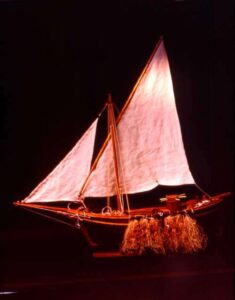Fishing
 Until the first half of the 20th century the Mediterranean coral was harvested with the help of boats provided with a special tool, known as the “ingegno”.
Until the first half of the 20th century the Mediterranean coral was harvested with the help of boats provided with a special tool, known as the “ingegno”.
It is a special web of ropes attached to a wood cross. The ingegno was lowered from the boat (called “corallina”) and dragged along the ocean floor. The boat movement helped tear the coral away from the rocks and bring it to the surface. Coral harvesting is no longer made in this way; it was replaced by the harvesting made by scuba divers, with great relief of those – we, coral craftsmen firstly – who have at heart that the natural sea environment remains intact and protected. Divers harvesting is definitely more selective: once the diver has spotted the rock where the coral is, he can harvest only the bigger branches, saving the smaller ones for the future.
It would be useless to take the small ones too: they are only used in minimal quantities in the manufacturing. The dark side of the medal is that the job of scuba diver is undoubtedly dangerous: the 15/20 minutes of harvesting on the sea floor mean 3 to 4 hours in the water for decompression’s sake, that is to say 8 hours in the sea for half an hour harvesting.
Moreover, coral is beginning to lack in the areas wher it was traditionally present. A diver must reach a depth of 100 metres and more to obtain a decent harvest!How expensive is all this? Luckily enough for the divers, operators and coral craftsmen, excellent coral is presently being harvested in Morocco, Tunisia, Algeria, which are very rich areas, coralwise. This new coral is controlling the cost of the raw material, and is making a kind of “ecologic peace” were there had previously been a hyperexploitation of the sea resources. In Japan coral gives completely different problems. Firstly the harvesting is made in the ocean, where coral is deeper than in the Mediterranean. The Ocean waters are dangerous, deceiving, overwhelmed by typhoons at least twice a year.These waters must be sailed by strong ships, bigger than the “coralline”: proper ocean ships, with which the Chinese and Japanese do the coral harvesting. Instead of the “ingegno” they use big round-shaped stones held by a rope, from which webs and laces hang. These webs, dragged on the ocean floor, tear away the coral branches. Presently, also in Japan this harvesting technique is being replaced by new techniques, with the use of submarines and robots, controlled from the surface. The use of such powerful – and expensive – instruments is justified by the fact that the japanese coral branches are much bigger (and therefore more valuable) than those in the Mediterranean.


